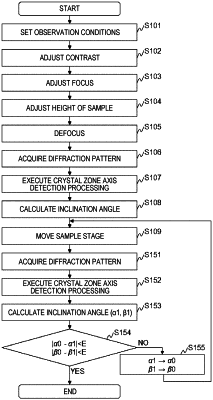| CPC H01J 37/28 (2013.01) [H01J 37/20 (2013.01); H01J 37/244 (2013.01); H01J 37/265 (2013.01); H01J 2237/2802 (2013.01)] | 14 Claims |

|
1. A charged particle beam apparatus that irradiates a sample with a charged particle beam to observe the sample, the charged particle beam apparatus comprising:
a sample stage that is configured to hold and move the sample;
a particle source configured to output the charged particle beam;
a plurality of lenses configured to adjust an irradiation direction and focus of the charged particle beam on the sample;
a detector configured to detect a signal emitted from the sample irradiated with the charged particle beam; and
a processor that is communicatively coupled to the sample stage, the particle source, the plurality of lenses, and the detector, wherein the processor is configured to:
control the particle source to output the charged particle beam,
acquire, using the detector, a diffraction pattern for the charged particle beam, wherein the diffraction pattern includes a plurality of Kikuchi lines,
calculate a crystal zone axis of the sample by performing analysis based on a plurality of intersections at which two Kikuchi lines included in the diffraction pattern intersect with each other,
calculate an inclination angle, which is an angle at which the sample is inclined, based on the crystal zone axis and the irradiation direction of the charged particle beam,
move, using the sample stage, the sample to a new location based on the inclination angle, and
obtain, using the detector, an image of the sample at the new location.
|